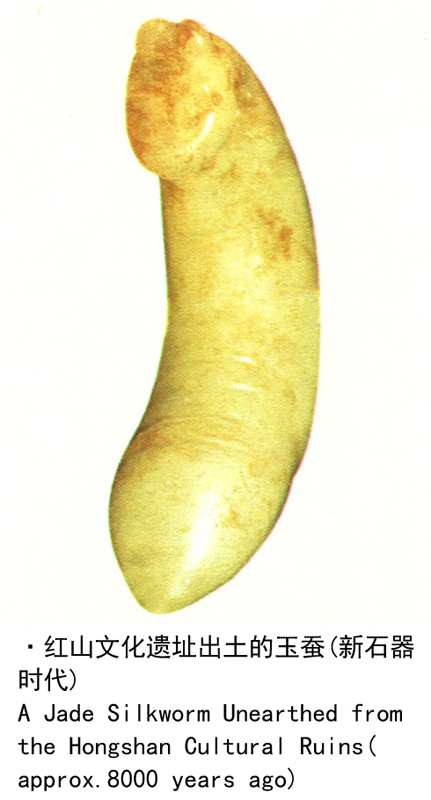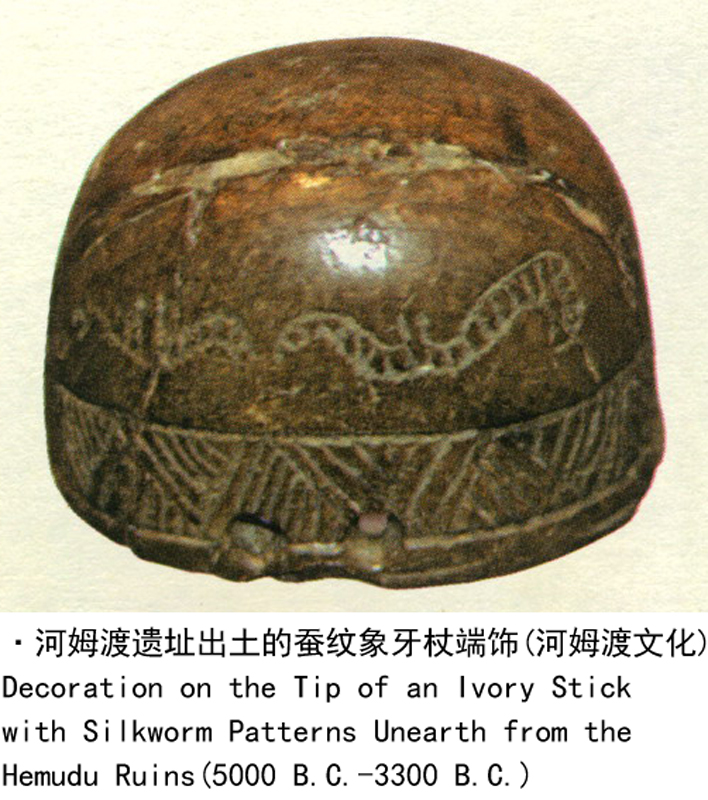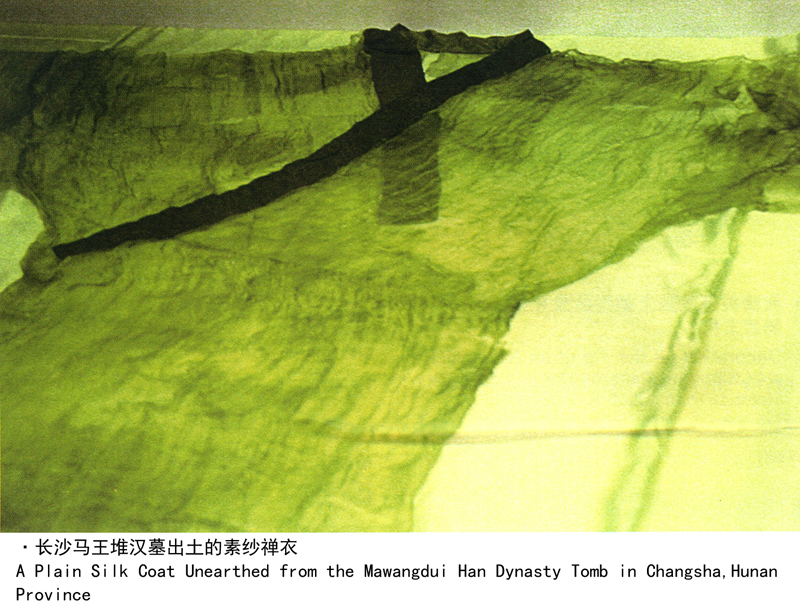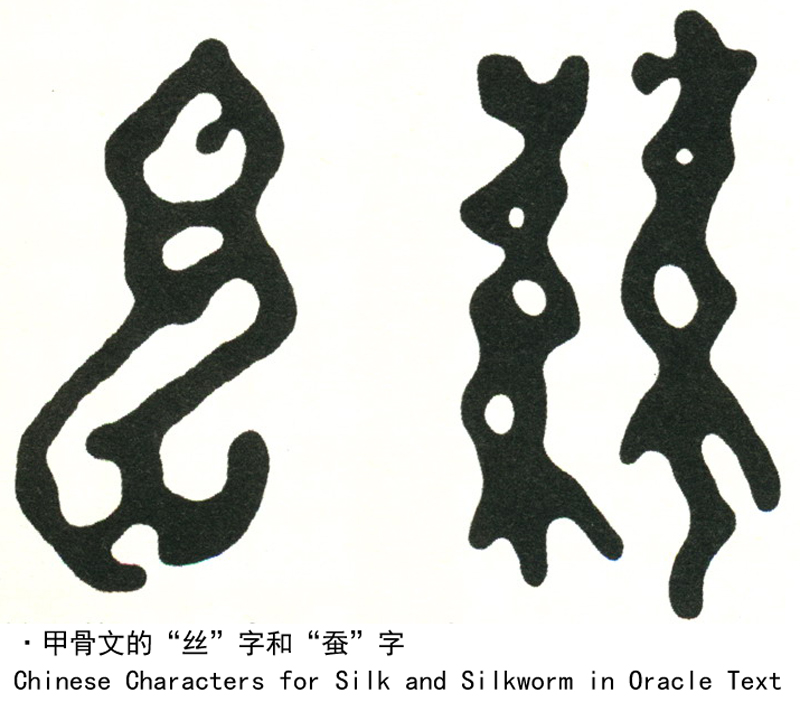丝路概说
- 交通路线
- 长安与丝绸之路
- 从长安到罗马——汉唐丝路全程探行纪实上
- 从长安到罗马——汉唐丝路全程探行纪实下
- 海上丝路史话
- 丝绸之路史研究
- 早期丝绸之路探微
- 早期丝绸之路文献研究
- 中西丝路文化史
- 沧桑大美丝绸之路
- 传播友谊的丝绸之路
- 路途漫漫丝貂情——明清东北亚丝绸之路研究
- 世界的中国——丝绸之路
- 丝绸之路
- 丝绸之路寻找失落的世界遗产
- 丝绸之路2000年
- 丝绸之路——从西安至帕米尔
- 丝绸之路经济带发展报告2014
- 丝绸之路考古十五讲
- 丝绸之路——神秘古国
- 丝绸之路——沿线城镇的兴衰
- 丝绸之路在中国
- 丝路景观
- 丝路起点长安
- 丝路文化新聚焦
- 丝路之光——创新思维与科技创新实践
- 中国丝绸之路交通史
- 中华文明史话-敦煌史话
- 中国·北海合浦海上丝绸之路始发港理论研讨会论文集
- 丝绸之路
- 丝绸之路新史
- 西域考古文存
- 丝绸之路的起源
▲从丝绸说起
作者:方明




中国是世界上最早养蚕和制造丝绸的国家。据史籍记载,中国人用蚕丝织成衣料,至今已有近五千年的历史。在远古传说中,黄河流域部落联盟首领黄帝的妻子嫘祖是第一个教人们养蚕缫丝、织造衣料的人,被尊为“先蚕娘娘”。1926年,山西夏县的新石器时代遗址中曾出土有蚕茧的茧壳;1958年浙江吴兴的新石器时代遗址中曾出土有碳化了的丝绒、丝带和绢片,经测定,其年代距今约4750年。可见在新石器时代晚期,黄河流域和长江下游地区的先民已经开始了丝织业。
夏商时期(约前2070—前1046),人们开始将野蚕驯养为家蚕。蚕丝的产量增加,促进了丝织业的发展。在商代的甲骨文中,已经出现了蚕、桑、丝、帛等象形文字。商代的一些青铜器上还刻有蚕纹,墓葬中也出土了形态逼真的玉蚕和各种精致的丝绸、刺绣残片,这些都说明当时人已经掌握了相当成熟而高超的丝织技艺。
西周乃至春秋战国时期(前1046—前221),蚕丝和丝绸的生产有了进一步的发展,丝织品的使用也更加普遍。在《诗经》、《尚书》、《国语》等文献中,关于蚕丝和丝织品的记载层出不穷。当时的丝绸不仅产地十分广泛,而且花色品种多达十几种,制作工艺相当精良。秦以后至汉代初年,中国蚕丝业进入了全面兴盛的时期。在长沙马王堆西汉墓中,发现了绢、锦、绣、罗、纱等多种鲜艳的丝织品,其中一件素纱禅衣长1.28米,共用料约2.6平方米,但仅重49克。在两千年前的古代,能够织造出这样高质量的衣料,堪称举世无双。在甘肃地区的河西走廊,也曾出土了不少汉代丝织品的残片,这些丝织物经纬细密,花纺精致,纹丽色艳,显示了织工的精良技艺。
美丽的丝绸不仅受到中国人的喜爱,也引起了中亚、西亚和欧洲人的浓厚兴趣。早在公元前5世纪,中国珍贵的丝绸就已经传到了西方。
>Starting from Silk
China was the first country in the world that engaged in sericulture and silk production.According to historical records,the history of using woven silk materials to make clothes dated back to almost five thousand years.As legend has it,Leizu,wife of Yellow Emperor who was head of the Alliance of Tribes in the Yellow River Valley,was the first person who taught native people the skills of sericulture,silk reeling and weaving.She was revered as Empress Silkworm.In 1926,cocoon shells were unearthed from ruins of the Neolithic Age in Xia County,Shanxi Province;in 1958 carbonized velvet,silk ribbons and silk scraps were unearthed from the Neolithic ruins in Wuxing of Zhejiang Province.After testing,it was confirmed that the silk pieces were made some four thousand seven hundred and fifty years ago.It is evident that Chinese ancestors inhabited in the downstream areas of the Yellow River and the Yangtze River already engaged in silk production during the late Neolithic Age.
The domestication of wild silkworms during the Xia and the Shang dynasties(approx.2070 B.C.-1046 B.C.)enabled the increase of the output of silk yarns and the development of the silk industry.In the Shang Dynasty Oracle text,hieroglyphic characters for silkworm,mulberry,yarn and silk appeared;Engraved silkworm patterns appeared on some Shang Dynasty bronze wares;Vivid and lifelike jade silkworms and a variety of fine silk,embroidery scraps were found in tombs as burial objects.All of these showed that people then already mastered the artistry of silk weaving to the level of sophistication.
During the Western Zhou Dynasty and the ensuing Spring and Autumn and the Warring States Period(1046 B.C.-221 B.C.),silk yarns and silk production enjoyed further development.Silk products became more popular.In the literatures such as The Book of Songs,Book of History,Remarks of Monarchs,there are numerous references to silk yarns and silk products produced in many parts of China and had more than a dozen varieties through sophisticated production processes.The post Qin period to early years of the Han Dynasty marked the heyday of China's silk industry.In a Western Han tomb found in Mawangdui,Changsha of Hunan Province,a variety of silk products with dazzling colors were found including thin and tough silk,brocade,embroidery,fine silk and silk yarns.A 1.28 meter long plain silk robe used about 2.6 square meters of silk material.Yet it weighs only 49 grams.Thanks to the unparalleled wisdom of the ancient people that made such high-quality silk available some two thousand years ago.Quite a few scraps of the Han Dynasty silk have been unearthed in areas along the Hexi Corridor in Gansu Province.These fine silk fabrics are tightly woven,with elegant patterns and dazzling colors,displaying the excellent skills of the then weavers.
The beautiful silk were not only loved by the Chinese people,but also triggered much interest of people in Central Asia,West Asia and Europe.As early as in the 5th century B.C.,the precious Chinese silk traveled to western countries.
丝绸之路/方明编著.-合肥: 黄山书社, 2013;